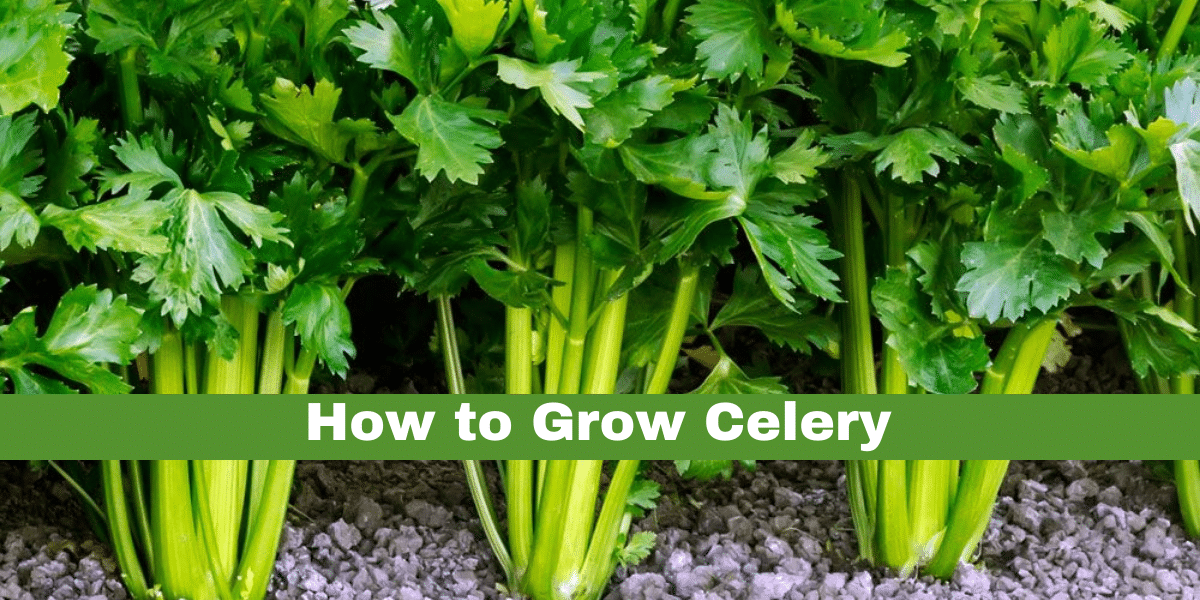Introduction of Growing Celery
Growing Celery Not exclusively is garden celery preferred tasting over locally acquired sorts, yet additionally, it’s less artificially loaded. In cool spring and summer areas, plant celery in late winter. In warm spring and summer locales, plant celery in mid to pre-fall for reap in late pre-winter or late-fall.
This growing celery requires four months of cool climate to come to gather. Celery is viewed as a solid biennial. However, it’s developed yearly which is developed for its edible 12-to 18-inch stalks. It’s not hard to develop celery, yet you must start celery from seed inside; transfers are difficult to come by and don’t generally succeed.
Overview Of Celery
Biological Name
Apium graveolens
Plant Type
Maturity Period
about 130-140 days
Maturity Size
12- to 18-inch
Soil Type
Loamy
Soil pH
6 – 8.5
Exposure
Full sun
Hardiness (USDA Zone)
4-10, some varieties hardy to 2 or 3
Spacing
12 inches
Bloom Time
4 to 5 months
Toxity
Non-Toxic
Flower Color
Light Green and White
Growth Rate
130-140 days
Native Zone
Mediterranean
Maintenance
Make a point to proceed with water at the normal level. Care: The outside temperature should be in any event 10 degrees Celsius alongside soggy soil. Adding bunches of mulch, and natural supplements to the plant is essential, as celery requires heaps of ‘food’ to make a big difference for itself.
History Of Celery
Celery, the amiable straight man of the vegetable world, packs a weak six calories for every tail and — as I would see it — probably as much flavor as a work area light. However, notwithstanding its constraints, the sinewy plant has been included in Mediterranean and East Asian human advancements for millennia.
Wild celery is local to the Mediterranean region, as per Davis. However, remaining archeological parts from Switzerland have proposed that people were moving celery seeds as right on time as 4,000 B.C. Another assortment of celery called “smallage” was available in China as right on time as the fifth century. Solid fragrance may have supported the allure of the assortments in the Mediterranean and Asia.
Nutritional Facts About Celery
Celery is an incredible wellspring of significant cell reinforcements.
Cancer prevention agents secure cells, veins, and organs from oxidative harm.
Celery contains nutrient C, beta carotene, and flavonoids, yet there are at any rate 12 different sorts of cell reinforcement supplements found in a solitary tail. It’s likewise a magnificent wellspring of phytonutrients, which have appeared to lessen aggravation occasions in the stomach-related lot, cells, veins, and organs.
Celery decreases aggravation.
Persistent irritation has been connected to numerous sicknesses, including joint inflammation and osteoporosis. Celery and celery seeds have roughly 25 calming intensifies that can offer insurance against aggravation in the body.
Celery upholds processing.
While its cancer prevention agent and mitigating supplements offer assurance to the whole stomach-related parcel, celery may offer unique advantages to the stomach.
Celery is plentiful in nutrients and minerals with a low glycemic record.
You’ll appreciate nutrients A, K, and C, in addition to minerals like potassium and folate, when you eat celery. It’s additionally low in sodium. Also, it’s low on the glycemic record, which means it has a sluggish, consistent impact on your glucose.
When To Plant Celery
Celery is a cool-climate crop. It requires four months of cool climate to come to collect. Start celery seed inside 8 to 10 weeks before the last ice in spring. Set transfers in the nursery 2 to 3 weeks before the expected last ice date when seedlings have 5 to 6 leaves. (To postpone relocating time and moderate development, slice seedlings down to 3 inches (7.6cm) tall and afterward permit them to develop on.) The cold climate will hinder development, as will the warm climate. Temperatures underneath 50°F (10°C) for over 12 hours may make a celery bolt. In cool spring and summer districts, plant celery in late winter. In warm spring and summer locales, plant celery in pre-fall for collection in late pre-winter or late-fall.
How To Grow Celery
Develop celery in fertilizer-rich, dampness retentive soil that verges on wet yet at the same time depletes. Celery leans towards soil with a pH somewhere in the range of 5.8 and 6.8. Celery has a low capacity to bear warmth and inclines toward a cool, overcast area where developing temperatures range somewhere in the range of 60°F and 70°F (15-21°C). Plant celery where the developing season offers four months of cool climate.
Planting And Spacing Growing Celery
Plant celery seed ¼ to ½ inch down, 6 to 10 inches (15-25cm) separated; space columns 24 inches (61cm) separated. Relocate seedlings began inside into channels 3 to 4 inches (7.6-10cm) profound set 6 to 10 inches (15-25cm) separated as plants develop hill up soil around the stems to whiten them. Plant self-whitening celery in blocks 6 to 12 inches (15-30cm) separated; planting nearer will give a better return yet more slim stalks.
Types Of Celery
- Brilliant Plume’
- ‘Brilliant Self-Blanching’
- ‘Green Giant’
- ‘Summer Pascal’
- ‘Red Celery’
- ‘Diva’
- ‘Utah 52-70’
- Harvest Celery
How To Harvest Growing Celery
Reap celery from summer and through the harvest time until the main complex ices stop development. In milder regions, celery may overwinter, creating incidental stems all through the coldest months at that point, getting again in spring before at long last extending to bloom.
- You can gather plants entire; however, cutting or picking singular stems as required will keep plants creating over a more extended period.
- The pieces of celery gathered are, for the most part, the stalks, which will be over the ground.
- Pick the stalks at whatever point you need. Youthful celery is comparable to the experienced item.
- Reap stalks from an external perspective. You may start reaping when stalks are around 8 inches tall.
- Celery can be kept in the nursery for as long as a month if the soil is developed around it to keep an ideal temperature. Celery will endure light ice, however, not back-to-back ices.
Growing Celery In Pots
Celery loves a dirt pH of 6.0-6.5, antacid. Limestone revised into acidic soil will cut the causticity. Pick a compartment in any event 8 inches down and long enough to plant extra celery plants 10 inches separated.
Try not to utilize unglazed mud pots, if conceivable, as they dry out rapidly, and celery likes to remain soggy. Plastic holders are an extraordinary decision in this example, as they keep up sodden conditions.
Revise the dirt with a lot of natural manure to help in holding dampness. Sow seeds eight to 12 weeks before the last ice. Germination takes around fourteen days. Plant seeds just 1/8 to ½ inch down, covered softly with soil.
For an 8-inch pot, plant five seeds with two creeps between seeds. I know they’re minuscule; do all that can be expected. When the seeds have grown, slim out the littlest significantly at the point when the plants are 3 inches tall, dainty out to one plant.
Growing Celery From Seeds
To begin developing celery from seed, it’s ideal to start the planting interaction around 10 or 12 weeks before the last spring ice. Splash the celery seeds for the time being to assist them with growing and fill your compartment with soil. When picking and filling your compartment, remember that your seedlings will arrive at statures of around two creeps before being moved and that celery inclines toward rich soil with a neutral pH of about 5.8 to 6.8.
Sow the seeds in lines divided around 1 inch separated and afterward cover the seeds with a half-inch sand. Add a layer of burlap or moist sphagnum greenery, which can stay there until the celery sprouts. Keep your maturing celery seeds in a brilliant region; however, stay away from direct daylight. In a perfect world, celery appreciates daytime temperatures of around 75 degrees Fahrenheit and evening time temperatures of around 60 degrees.
Marshland Plant
Marsh is a wetland environment described by ineffectively depleted mineral soils and by vegetation overwhelmed by grasses. The last trademark recognizes a bog from a marsh, whose vegetation is overwhelmed by trees. The quantity of plant species in bogs is not much contrasted, and those that develop on all-around watered, however not waterlogged land. Grasses, grasslike sedges, and reeds or surges are vital.
The inclination of the stream approaches zero at the ocean, where the stream is languid. Since the delta is kept by dregs settling from the stream water, the constructed land will be inadequately depleted at its driest and will regularly be submerged. Dregs provided by the stream have regularly been disintegrated from the surface soils of the waste bowl and are in this way rich.
Growing Celery (Apium graveolens) is a marshland plant in the family Apiaceae developed as a vegetable since vestige. Celery has a long stringy tail tightening into leaves. Contingent upon area and cultivar, either its stalks, leaves, or hypocotyl are eaten and utilized in cooking.
Regrow Celery From Scraps
Remove the end
Cut around two creeps off the root end of a lot of celery.
Spot in water
Set the celery in a shallow glass bowl or container. Load up with enough water to lower an inch of the root end. Spot the bowl or container where it can get great ordinary light for a few hours per day.
Watch it develop
Following a couple of days, you should begin seeing tiny leaves arising out of the actual focus of the top. You may see little stalks and leaves and small roots arising around the base in about seven days.
Replant in soil
At the point when the new roots are about an inch long, you can plant the celery in fertilized soil or straightforwardly into your nursery. On the off chance that you use fertilized soil, pick a blend without pesticides and reasonable vegetables and spices.
Pests And Diseases of Growing Celery
Celery Pests: Celery generally experiences no genuine vermin issues except for can be assaulted by celery leaf excavator and slugs (during whitening).
Celery Diseases. Pink decay, dark heart, and curse can assault celery. Ensure there are sufficient magnesium and calcium in the dirt to debilitate these infections.
Celery Fertilizers: Utilize a total compost with a high proportion of potassium (4-4-8). Plants: Celery is by and essentially relocated. Transfers ought to have 3-4 developed leaves and a grounded root framework before planting in the nursery.
Troubleshooting Steps of Growing Celery
- Keep celery planting beds weed-allowed to stay away from the contest for dampness and supplements.
- Keep development shallow not to harm roots—Whiten celery to improve its sweet flavor and brighten stalks.
- Growing Celery that isn’t whitened can be unpleasant tasting. Whitening is accomplished by covering the stalks with soil, straw, or paper chambers moved up to the highest point of the stalks to shield them from the sun, which urges them to create chlorophyll and become green.
- Whiten celery up to 10 to 14 days before gathering. Celery that sits too long after whitening will get concise and may spoil.

